Physical Address
304 North Cardinal St.
Dorchester Center, MA 02124
Physical Address
304 North Cardinal St.
Dorchester Center, MA 02124
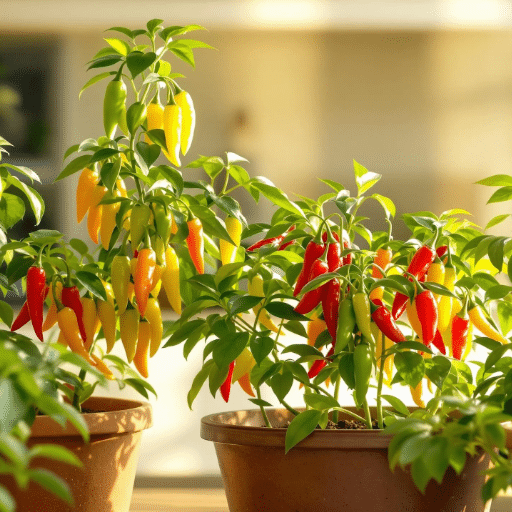
Making hot peppers from your own indoor garden can be a fun and fruitful undertaking, no matter if you’re a novice or a seasoned gardener. With their bright hues, small stature, and hot tastes, hot peppers are a great choice for not only giving your kitchen or living room a refreshing look but also providing you with a steady supply of fresh ingredients throughout the year. This article aims to guide you through the entire indoor pepper gardening process, from picking the right kinds to offering the best plantation conditions. With the indoor hot peppers that are so satisfying to harvest and consume, it’s time to liven up your place and reap the benefits of your nascent green thumb!
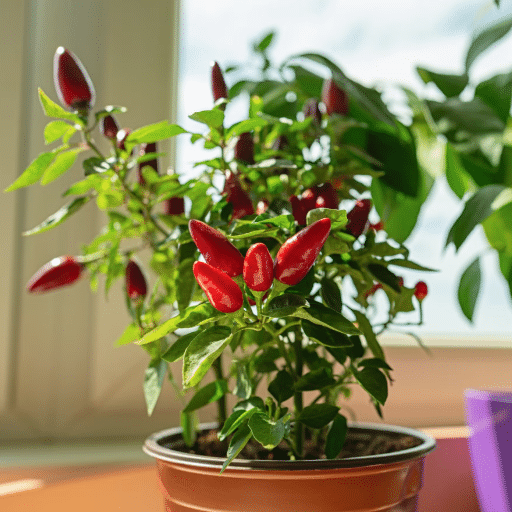
Indoors grown chili plants are mainly those that are being grown in a controlled environment inside your house where you are able to harvest the chili all year round. Nevertheless, for indoor peppers to flourish, they need warm and sunny conditions with a lot of light, 12-16 hours of sunlight per day or grow lights as the light. Choose small or dwarfed varieties for easier indoor management, such as jalapeño, Thai chili, and bell peppers. Ensure good drainage for your plants, water them regularly, and use a well-drained potting mix. If you put in the right amount of care and attention, you can harvest indoor pepper plants that are packed with flavor and good for your enjoyment.
The indoor pepper growing method has a lot of benefits; thus, it is a rewarding and tricky option for many. Growing peppers indoors means you can have fresh home-grown peppers 365 days a year. It also gives you the power to completely control your growing environment, which prevents pests and diseases common in gardens from bothering your peppers. Furthermore, growing peppers indoors is also a space saver, so it is perfect for those living in a city or a small house. If you harvest the peppers from your indoor garden right, they will not only add a punch of flavor to your meals but also lessen the need for buying produce from the supermarket.
When it comes to the right indoor gardening pepper varieties, you should think about space, light availability, and personal taste as the main factors. Space is determined by the size of the compact varieties, which could be as small as mini bell peppers, chili peppers, and jalapeños; all of which are suitable for smaller areas and do not mind the indoor climate at all. Besides, choosing varieties with shorter maturation times assures a faster harvest; thus ensuring robust mini plants. If it is a sweet pepper, then the choice will be sweet bell peppers, and in case one prefers spice, one may go for cayenne or habanero varieties. Always ensure that the environment you create is compatible with the variety you choose; provide adequate light and offer proper care to ensure successful growth.
There are many reasons to grow hot peppers indoors. Firstly, it allows for the uninterrupted production of fresh peppers that can easily be sold in the market all year round, regardless of the climate outside. Plants grown indoors are typically healthier, as they are protected from the bugs and diseases that gardeners get from their gardens. Factory-like pest control is also another advantage of indoor growing, as light, humidity, and temperature can be artificially regulated to improve plant productivity. Hot peppers coming from the indoor farm can also be a gossip topic in the neighborhood because of their colorful fruits not only being a visual joy but also being a source of very interesting flavors. Finally, home cooks can enjoy the great taste and heat of their own spices without being bothered by any supply shortage issues.
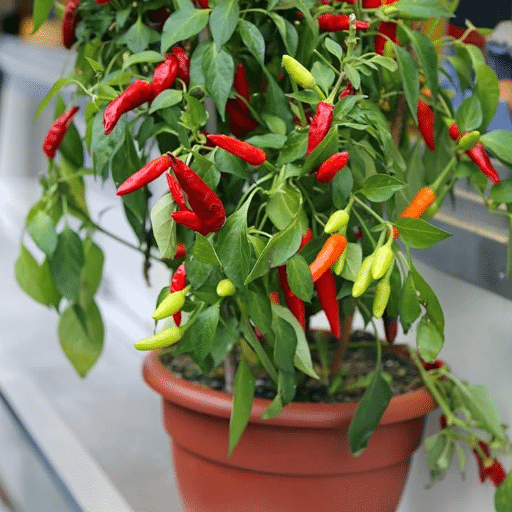
The very first step to having an indoor pepper garden is to choose the right pepper varieties. Pick from the small, compact types like jalapeños, cayenne, or chili peppers which are the ones that will do the best in the indoor setting. It is always the best practice to use either quality seeds or starter plants that are healthy. It is also good to consider your personal taste for spiciness and the intended cooking methods as a guide in your choice. It will certainly be easier and more productive if you choose the varieties that are suitable for indoor conditions.
Sourcing high-quality seeds from a trusted supplier will be the first step for planting pepper seeds as this will guarantee good plants. If you decide to get seeds from fresh peppers, always choose fully matured ones. Soaking the seeds in warm water for 8-12 hours will be the next step which helps to soften the seed coat thus speeding up germination. A seed-starting mix that is light, well-draining, and nutrient-rich will be the ideal medium for small containers or trays. The seeds should be sown about 1/4 inch deep and lightly covered. A warm environment, preferably between 70-85°F, should be created in order to germinate seeds. Water the soil regularly but do not make it soggy since that might kill the seeds with rot. Plants should be kept in a well-lit area or a grow light should be used to ensure that there is adequate light for good sprouting.
The seedlings need constant supervision throughout their development if they are to survive at all. The seeds should be placed in a very bright area, perhaps near a south-facing window or under grow lights, and they must be lighted for 12-16 hours every day, otherwise, they will turn to be weak and leggy. Soil moisture has to be monitored very carefully; it should always be uniformly moist but not soggy to prevent root rot. A temperature range of 65-75°F is regarded as the ideal for healthy growth, and it is very important to have good air circulation in the growing area to avoid mold or fungal problems. As soon as the seedlings grow their first true leaves, they are ready for fertilization with a diluted balanced fertilizer, which will supply the plants with the necessary nutrients.
To use grow lights effectively means to firstly choose the right kind of light, whether it is LED, fluorescent, or HID based on the specific requirements of the plant and its growth phase. It is crucial to have the lights positioned in such a way that they will be giving off just the right amount of intensity but that they will be too far away to result in heat damage; generally speaking, 6-12 inches is the best distance for seedlings. It is essential that the lights are kept on for 12-16 hours a day which will therefore mimic natural daylight cycles and the use of a timer would be a great help in keeping that regularity. Keep an eye on the plant reaction and adapt the light duration and distance as needed. Turn off the lights and clean them regularly so that they can give their best and also follow the manufacturers’ instructions with regards to changing bulbs so that you always have the right light spectrum and intensity.

For the effective indoor growth of pepper plants, a container with drainage holes should be used in combination with a well-draining potting mix to avoid waterlogging. Roots need space so choose pots of at least 10-12 inches deep. Count on the consistency of watering the plants; keep the soil moist but not soggy, and choose a spot that gets at least 6-8 hours of bright, indirect sunlight every day. If the natural light is not sufficient, then you can use grow lights as a supplement to ensure good growth. Fertilize plants with a balanced liquid fertilizer every 2-3 weeks according to the instructions on the product. Always be on the lookout for pests or diseases, and remove any yellowing or damaged leaves to keep the plant healthy.
When you are buying a pot for your pepper plant, it is necessary that the pot has drainage holes so that water does not accumulate since peppers can easily get root rot and they are very sensitive to that. The size of the pot should be such that it is 12 inches both deep and wide so that there will be sufficient space for roots to grow and thus the whole plants development. Plastic, ceramic, or terracotta are good materials but be aware that terracotta can absorb water faster. Also, dark pots may cause heat retention, which can be beneficial for the plants during winter but might cause trouble during summer. Always consider the specific requirements of the pepper plant and the environment for the best growth conditions.
Indoor peppers are happy in soil that drains well, is rich in nutrients, and has a slightly acidic to neutral pH, mostly at 6.0 to 7.0. The best soil for this is a mixture of a high-quality potting mix with the addition of compost or organic matter as it provides the necessary nutrients and at the same time keeps good aeration. Do not use garden soil as it may compact in pots and thus prevent root growth. You may also add perlite or sand to the soil to help with drainage. The soil should be checked for moisture regularly; keep it consistently moist but not waterlogged to ensure healthy growth of the plants.
Watering your indoor garden needs to be done with great care so as not to end up with overwatering or underwatering. Check the soil often and water only when the top inch is dry. Use water at room temperature so that the plants are not shocked, and pour just enough to moisten the soil without making it waterlogged. Fertilizing is as important as watering for sustaining plant growth. Select a balanced, water-soluble fertilizer and apply it according to the instructions on the label, usually every 4-6 weeks. Modify the frequency and type of fertilizer according to the particular needs of your plants since some may need more nutrients during their active growing seasons.
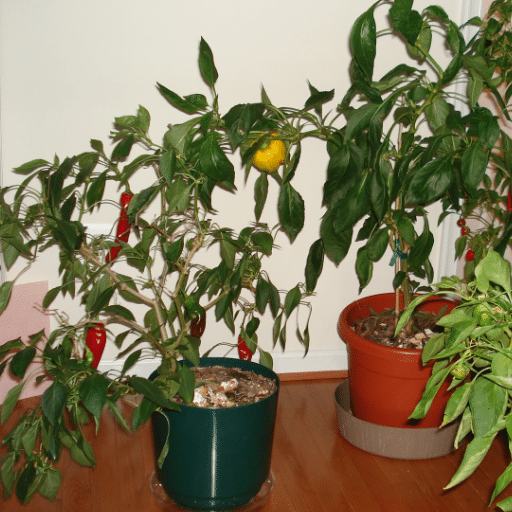
In case you have indoor pepper plants and want to know how to overwinter them successfully, then performing the following actions would help:
Pruning the Plants: Cut back the plant and get rid of any dead or diseased parts of the plant to reduce the overall size. Winter will take less energy due to this practice.
Pest Check: Look through the plant very carefully for any pests and deal with them if there are any before you take the plant inside.
Location Selection: Put the plant in the warmest place where there is a lot of bright, indirect light. A south-facing window or grow lights would be suitable.
Sparingly Water: Only water when the soil is dry on top, since too much water can cause the roots to rot.
Humidity Control: Use a humidifier to keep humidity or simply put a tray filled with water beside the plant.
If you practice these steps, the pepper plants will stay strong and healthy till the return of the growing season.
When getting your pepper plants ready for winter indoors, the first step is to give them a good cleaning to get rid of any pests and dirt. Secondly, prune the plants by removing the extra leaves and stems to control their size and promote healthy growth. Next, put the plants where they can get a lot of bright, indirect sunlight either by a south-facing window or through grow lights. After that next step, water only when the soil is dry in order to prevent overwatering, and control humidity with a humidifier or by having a tray of water close by. The following actions will keep your pepper plants flourishing indoors throughout winter.
Once pepper plants enter dormancy, they need little care to stay alive. Do the watering very sparingly and allow the potting soil to dry to avoid root rot. Besides the plants, the cool area with good lighting is the preferred spot–temperature in the 55F-70F range is ideal. Remove any dead or sick leaves; encourage the plant with nice growth the moment it turns active again. You should not fertilize the plant during this time since its nutrient requirements are very little, just like when it is dormant. Besides, keep a close watch for pests; when detected, treat with soap or any other method suitable. By adopting these measures, you can take it for granted that your pepper plants are strong and ready for the upcoming growing season.
The moment pepper plants exhibit slow growth signs, like fewer new leaves or a reduction in blossoms, they are ready to be placed in the wintering area. Also, these plants should not be infested with pests nor have any diseases before the start of the wintering process. If the stems being healthy, with no discoloration or damage, and the foliage looking good are the signs that the plant is in a position to withstand dormancy. If repotting becomes mandatory, check the roots and make sure there are no signs of rot or that the plants are not overly crowded. After all these conditions have been satisfied, you are ready to usher in the plant’s dormant phase with no worries.
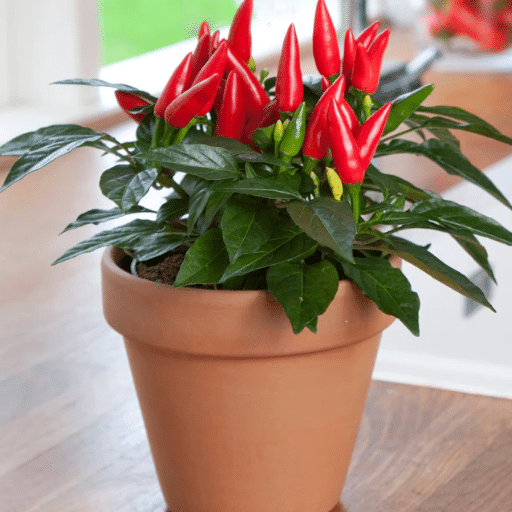
Proper timing and care are the essential factors for the successful harvesting and production of fruits. Let the fruit stay on the plant till it is fully ripe in order to get the best flavor and quality. Changes in the fruit’s color, texture, and aroma usually signal the right time for harvesting. Handle fruit gently during picking so as not to bruise or injure the plant. For better production of fruits, give the plant enough light, water and balanced nutrients all through the growing season. Also, regular pruning and pest control will ensure the yield is healthier.
The mature color of indoor peppers will be the indicator for harvesting, which depends on the variety—mostly red, yellow, or orange. Look for a firm texture and a shiny appearance as the indicators for the right moment. Picking too early should be avoided at all costs, as it may lead to loss of flavor and nutrients. Either gently twist or cut off the peppers from the plant to avoid damaging them. Keep a close eye on the plants so that you can harvest at the right time and also encourage the production to go on.
For indoor conditions, maximizing fruit production mainly depends on the light provided to the plants which is the primary factor for photosynthesis and fruit development. Full-spectrum grow lights manufactured for plants will be the best choice and putting them close enough to the plants will simulate the effect of natural sunlight. Keep the temperature and humidity levels stable as changes can be a cause of stress to the plants. Watering and feeding will be done regularly with a balanced fertilizer, especially for fruiting plants which will cater for the required nutrients. The pruning of excessive leaves will be done so as to provide air circulation and direct energy to fruits only. The pollination will be made possible through shaking the plants lightly or using a soft brush to move pollen from one flower to another. With the right indoor conditions, the plants can flourish and offer copious fruit.
Pepper plants after harvesting need to be taken care of in a way that they will still be healthy and produce fruits. The first step is to get rid of damaged or very ripe fruit because they can attract pests and the spreading of diseases will be easier. A slight pruning of the plant should be done to help it get its shape back and that would also mean encouraging the growth of the new shoots. If you are growing plants indoors or in pots, do check the health of the soil and if it is not good, be sure to add compost or organic matter to refresh it. Do not stop watering the plants but be careful not to let the soil get too wet. Fertilizing should be done in small quantities and the focus should be on balanced nutrients which will help recovery rather than on profuse fruit production. Always check for any signs of pests or diseases on the plants and if any problem is detected, take action immediately. By giving careful attention, pepper plants will continue to be productive and possibly will give another harvest.
The indoor germination of pepper seeds is a delightful undertaking and the first step is to take a quality seed selection. Choose seed trays or pots and fill them with a soil mix that is appropriate, so the seeds will have nutrients for germination. Heat mats can be considered for warm conditions to help with germination. Seed trays should be located in a spot where they can get plenty of sunlight, either through a window or under a grow light. You can move the seeds to bigger pots or grow bags when they are sprouted and strong and now seeing the soil moisture regularly will help you get seedlings that grow well.
Several essential factors are necessary for the successful indoor pepper plants. The first and most important is that enough sunlight should come for them, preferably around 12-16 hours a day, and if natural light is not adequate, then LED grow lights can be used as an alternative. A well-draining potting soil is very vital for healthy root systems and maintaining a constant temperature makes the plants grow well. Proper watering is key; the soil has to be moist but not soggy. Moreover, manually pollinating blossoms can increase the output of fruit, especially if you are growing sweet peppers or more exotic ones like ghost peppers. Besides, be careful about the pot size; bigger containers allow more extensive root growth.
Undoubtedly, you can grow different kinds of peppers indoors successfully: sweet, banana, and even the more demanding ghost pepper plants. Every type of pepper has its peculiar conditions; thus, it is a good idea to consult different growing guides on the specifics of the peppers you intend to plant. In most cases, although not exactly the same for different kinds, the indoor pepper plants will be similarly dependent on warm temperatures and light conditions. In the long run, you might learn indoor varieties that are most preferable to your circumstantial factors. Just make sure that the plants have enough space to grow their roots and also provide them with sufficient care to make them bear fruits.
The indoor pepper seedlings care is based on watering, lighting, nutrition and other factors monitoring while the plants are young. Give them a potting mix rich in nutrients and enough sunlight or grow light exposure to start with. As your seedlings grow, keeping the soil evenly moist is critical, but do not overwater, as that can result in root rot. When the seedlings form a strong root system, you can think of transplanting them into bigger containers or grow bags to further promote their growth. Fertilization with balanced fertilizer can also be helpful in the growth of seedlings as they go through maturation. Stay on the lookout for pests and diseases, as indoor plants can get infestations too.
It won’t hurt to assist indoor pepper plants in pollination since they might not get proper wind or insect pollination. You can do hand pollination using a small brush or lightly shaking plants to help the pollen transfer from male to female flowers. This is particularly critical for early peppers and when they are grown inside in winter, when natural pollinators are less active. The morning is the best time for the flowers to be pollinated because that is when they are most receptive. With practice, you can effectively increase the chances of your pepper plants producing fruit, ensuring a bountiful harvest.